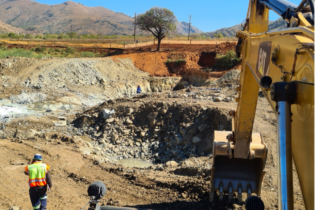Mining and industry are still coming to terms with the latest regulations of the National Water Act, which demand more attention to safety risks and more detailed reporting to authorities regarding compliance, construction and operation of dams.
“Every dam with a safety risk must now be classified, and that classification brings with it a range of legal obligations for the dam owner,” says Manda Hinsch, principal scientist and associate partner in SRK Consulting’s Pretoria office. Dams need to be classed as small, medium or large, depending on the height of the dam wall, while their hazard potential needs to be classified in terms of their potential adverse impact on surrounding water quality, potential loss of life and potential economic loss that might be caused by dam failure. Quality a concern “A crucial part of the new regulations is that they are concerned with the quality of the water being stored,” says Hinsch. “If the dam contains water containing waste, as many mine dams do, then the potentially negative impact on resource quality is regarded as ‘significant’ or ‘severe’. This raises the dam’s hazard potential, irrespective of size, as well as the owner’s level of obligation and liability.” The new regulation and compliance requirements have yet to be taken on board by many companies, which do not appear to be fully aware of the new regulations and their legal implications, she says. Among the new requirements is the need to prepare an emergency preparedness plan (EPP) and an operation and maintenance manual once the hazard potential reaches Category 2 status. At the lowest end of the risk spectrum is a Category 1 dam, for which the conditions are a capacity of at least 50 000 m3 of clean water, a wall height of between 5 and 12 m, and low potential adverse impacts. With a Category 2 dam, the design standards become stricter, in response to the higher risks of impacting the natural and human environment. “An inspection of a Category 2 dam, for instance, can only be done by an approved professional, someone who is registered in this role by the Department of Water Affairs. A number of SRK water specialists hold this status,” says Hinsch. The more onerous Category 2 dam listing can apply even to a small dam, if the hazard potential is rated as significant or high – as defined by the regulations. This is where many mines may be underestimating their liability in terms of inspections, maintenance and operations, says Hinsch. The possible implications of the new regulations are significant, as there are more than 3 400 small dams in South Africa’s total of 4 700 registered dams, while more than 1 000 are medium-sized and less than 200 are large.“In terms of the new regulations, owners of registered dams in the country need to put in place an operations and maintenance manual,” she said. This will outline the operating procedures necessary to keep the dam compliant and to identify any warning signs – such as cracking, movement and leakage – that may indicate future problems.
The manual links closely with the required EPP, which must plan for three levels or ‘situations’ of emergency. At the lowest level (Situation C), procedures must be in place if the observer is unsure of how serious a problem is and needs professional advice. The symptoms to trigger this step include turbid seepage with soil particles at less than one litre per second or an unusual increase in leakage levels. They could also include wet patches on the downstream slope, deep erosion upstream or downstream, erosion in the spillway channel or defective outlet valves. Situation B The next level in the EPP (Situation B) is about preparedness, where persons involved are alerted to a possible evacuation. Possible triggers would be turbid seepage at more than a litre per second, blockage of the spillway or water levels rising to near the non-overspill crest while heavy rain is still falling. The highest level of emergency (Situation A) requires a warning system to evacuate the downstream area. This would apply when the dam wall has failed and water flows downstream, or where there is heavy flooding and water flows over the wall crest. It could also be invoked where signs of serious damage have been identified, such as excessively large cracks in the wall, unusually damp spots in an earth wall, or where movement like sink holes or sliding has taken place. “SRK is well qualified to assist dam owners in compiling required documentation, liaising with relevant authorities and undertaking dam inspections to ensure compliance of the dam as we have all disciplines and required specialists within our company,” says Hinsch. “But the regulations go quite a lot further than this. Even the alteration, expansion or repair of an existing dam needs to go through an official process, who must issue a licence before any construction work can take place.” The building or upgrading of dams, as well as their decommissioning, is also subject to regulatory control. When a dam is planned, a feasibility study first needs to be done and submitted to the Department of Water Affairs. At this point, the department can categorise the dam according to its criteria, and this clarifies the legal obligations on the owner. Dam safety inspections must be done every five years – on any category of dam – and a new dam must be initially inspected just three years after completion.







